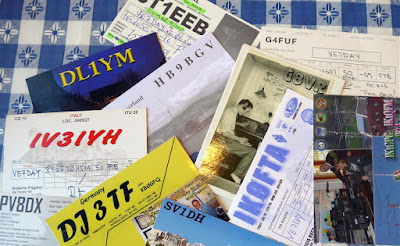 AmateurLogic 146: Hot August Night
AmateurLogic 146: Hot August Night
AmateurLogic.TV Episode 146 is now available for download.
Tommy builds an edge lit callsign display. Mike gets started with the Grove Beginners Kit for Arduino. Emile finds the ultimate dashboard monitor display for Raspberry Pi. Terry, 2E0IPK joins us to show how he uses his Buddi Stick.
Announcing the AmateurLogic.TV 15th Anniversary Contest. This perfect QRP package includes the Icom IC-705 all band all mode transceiver and Utility Backpack, MFJ-2289PKG Big Ear Antenna package with tripod and carry bag, MFJ-4115 portable power supply, and Heil Sound BM-17 headset. Help us celebrate. Visit amateurlogic.tv/contest today for details.
1:16:25
George Thomas, W5JDX, is co-host of AmateurLogic.TV, an original amateur radio video program hosted by George Thomas (W5JDX), Tommy Martin (N5ZNO), Peter Berrett (VK3PB), and Emile Diodene (KE5QKR). Contact him at [email protected].
 LHS Episode #361: The Weekender LIV
LHS Episode #361: The Weekender LIV

It's time once again for The Weekender. This is our bi-weekly departure into the world of amateur radio contests, open source conventions, special events, listener challenges, hedonism and just plain fun. Thanks for listening and, if you happen to get a chance, feel free to call us or e-mail and send us some feedback. Tell us how we're doing. We'd love to hear from you.
73 de The LHS Crew
Russ Woodman, K5TUX, co-hosts the Linux in the Ham Shack podcast which is available for download in both MP3 and OGG audio format. Contact him at [email protected].
 New SOTA Mountain Goat: Joyce/K0JJW
New SOTA Mountain Goat: Joyce/K0JJW
Congratulations to my wonderful spouse and favorite hiking partner, Joyce/K0JJW, for achieving Mountain Goat status for Summits On The Air (SOTA).

On August 10th, she reached 1000 activator points while activating Pikes Peak (W0C/FR-004). She had quite the pileup on 146.55 MHz. Her best DX for the day was WY7ATH near Cheyenne, WY at a distance of 167 miles. Not bad!
Early on, she always hiked with me on SOTA activations but didn’t start pursuing activator points until the middle of 2017. All of her SOTA contacts have been on the VHF/UHF bands, lots of 2m FM along with 2m SSB, 70 cm and 23 cm FM.
Joyce has activated 181 summits, 112 unique in 19 associations.
She is the second female Mountain Goat in Colorado (after Lynn/KC0YQF) and is the eighth female goat in North America.
73 Bob K0NR
The post New SOTA Mountain Goat: Joyce/K0JJW appeared first on The KØNR Radio Site.
Bob Witte, KØNR, is a regular contributor to AmateurRadio.com and writes from Colorado, USA. Contact him at [email protected].
 WHAT THE HECK!!
WHAT THE HECK!!
 |
| Hard to capture wonky SWR situation |
Well back to the topic at hand, I had my cables disconnected and the 3x5 card in place as we did have some severe weather roll through town the night before. I connected the cables, turned on the radio and started my PC. My plan was to get some FT8 contacts in the log before supper prep had to be done. As my rig was transmitting my LDG 200AT pro II turner started clicking which meant it was going through a tune session. This was odd as the tuner memory already selected the sweet spot and it was proven by the SWR meter on the Icom 7610. BUT......as I continued to transmit the SWR was going "wonky" and the LDG tuner was engaging to correct the issue.
There sure was an issue and I'm not feeling good about it. My troubleshooting began and here is what I did:
- I went to antenna 2 on the Icom 7610 which was connected to my dummy load. I transmitted into it at full power for about the time of an FT8 transmission. The result was no SWR issue so the 7610 seemed to be ok.
- I then connected the LDG tuner between the dummy load and my transmitter. I know there is no miss-match but if the LDG tuner was acting up it may do it in this ideal matched situation. The result was the tuner did nothing when I transmitted.
- I do have an LDG antenna switch (LDG DTS-4) in the maze as well. Once again I transmitted into the dummy load through the LDG tuner and then the LDG DTS-4 to the dummy load. Low and behold the tuner was trying to find a match again!
Mike Weir, VE9KK, is a regular contributor to AmateurRadio.com and writes from New Brunswick, Canada. Contact him at [email protected].
 Some 6m Summer Excitement
Some 6m Summer Excitement

With three seasons of FT8 under its belt, there’s no doubt that it's taken over as the number-one mode for the 6m band ... there are very few traces of CW or SSB to be found.
What it hasn’t taken away, is the magic!
For the most part, this summer’s conditions from the west coast were pretty normal, except for when they weren’t ... and when they weren’t, they were pretty spectacular!
The spectacular parts were highlighted by one particularly unique contact that can only be attributed to some heads-up operating skills, a little help from FT8 ... and the unpredictability of Sporadic-E.
On June 20, at 0056Z, K7CW (Paul), south-west of Seattle, nudged his signal all the way to Hong Kong, more specifically, to VR2ZXP’s crowded apartment building. But that’s not the incredible part. That happened when Paul heard and exchanged signal reports with Alfred’s tiny station!
 |
| Paul, K7CW |
 |
| Not the best location for weak signal 50MHz DX! |
"As I told to Paul, it’s a hard job to be a ham in VR2 Hong Kong especially for the DX. Hong Kong is a high density population city. 99% people are living in apartment only. The housing price here is crazy around US$1800 per sq. feet. Neighborhoods always complain why we setup antennas out of our windows and produce radiation to affect their health. So, what we just can do is to use a small whip with QRO for the QSO. Besides, interference is also serious. Thousands of air conditioner is surrounding me and a power station 132kV to 11kV is just faced to me in 1km away. Here the noise level on low HF band at night is S9."
As indicated above, Alfred’s station is located in a typical high-rise apartment, surrounded by numerous others, with no room for antennas. His solution is to clip a short (60”) whip antenna, horizontally mounted on his balcony railing, similar to this one from 20 years ago ... before being surrounded by noisy high-rise apartment buildings!
I’m not sure which is the most spectacular part of this contact ... that Alfred could detect Paul’s signal in such a noisy environment using such a small makeshift antenna or that Paul was able to copy the tiny signal coming from uptown Hong Kong.
 |
 |
| K7CW's 9el - 50' Yagi at 80' |
Long openings like this occur very rarely, making them even more thrilling and can cause even the most experienced 6m DXer’s mouse-hand to tremble with excitement!
 |
| Some of VE7DAY's wallpaper from the May 31st opening. |
Others up and down the west coast also filled their log pages with ‘new ones’ ... unfortunately my exciter was on the workbench while replacing the screen so I never knew what I had missed until some time later ... probably just as well. I guess I must have been pretty naughty at some point, as the 6m gods definitely singled me out for special punishment that morning.
Once the exciter was back together I was able to catch a few good openings myself, the best of which was early on the morning of June 23 when I was able to work SV9CVY (Crete), SV1DH (Greece) and IS0AWZ (Sardinia).
Crete and Sardinia gave me DXCC #89 and #90. Three days later, during a nice opening to the southern states, J68HZ in St. Lucia snuck through the QRM for #91. After a further three days, on June 29, another very early opening put 8 more Europeans in the log including HA8CE (Hungary) and YU7EF (Yugoslavia) for #92 and #93 respectively.
The band also produced several long openings to Asia, usually in the late afternoon hours. Several contacts were made with South Korean stations, China and dozens with Japan.
All told, the band produced some exciting activity this summer. Countries worked here were:
JA, JW, TG, V31, J68, LA, SM, SV9, SV, IS0, EA, HA, YU, F, 9A5, BG, HL, EA8. Certainly FT8 had much to do with a good portion of the action but it is difficult to say just how much. Many of the Europeans were very strong and could have easily been worked on CW in a matter of a few seconds, rather than the 60 - 75 seconds required for a valid FT8 exchange, assuming there are no repeats. But it's contacts like Paul and Alfred's that continue to validate the special name given to the band ... you just never know what might tricks will be next.
Steve McDonald, VE7SL, is a regular contributor to AmateurRadio.com and writes from British Columbia, Canada. Contact him at [email protected].
 Latest TX factor Show is Live
Latest TX factor Show is Live
A post-lockdown special – well, not really! Just a bumper edition of TX Factor that was planned for March 2020, but due to the Covid-19 restrictions never quite happened! We hope you are all safe and well, and enjoying the summer opportunities for amateur radio despite the various restrictions upon us. Back in February we dropped in for tea and biscuits at the new(ish) QTH of Tim Kirby GW4VXE to learn more about his passion for all things VHF / UHF. Also in February, Bob and Mike fitted a Radio Analog PTRX-7300 RF interface module into Bob’s beloved IC-7300, and, yes, can it be possibly true . . . bang up-to-date, Bob reviews one of the first Icom IC-705 SDR QRP all-mode transceivers in the UK. We hope you enjoy the show! http://www.txfactor.co.uk
Nick Bennett 2EØFGQ co-hosts TX Factor with Bob McCreadie GØFGX and Mike Marsh G1IAR. Contact the team at [email protected]
 New Contest for DXers and Portable Operators
New Contest for DXers and Portable Operators
For Immediate Release

Ridgeland, Mississippi— August 10, 2020 — A new contest has been announced that will level the competitive playing field between the Big Guns and the Little Pistols who operate a portable station. It’s called the Fox Mike Hotel Portable Operations Challenge. “The scoring metric is the distance-per-power metric with multipliers for portable operators and the difficulty of the transmission mode,” said Ed Durrant DD5LP, a member of the Steering Committee for the POC. “We are using kilometres-per-watt as the score for a contact. But those using a more difficult transmission mode such as phone will get a higher multiplier than those using the more efficient modes of CW and digital. Being a portable station will receive an additional multiplier, especially when contacting another portable station.” The scoring system is based upon the golf metaphor of the handicap index used to equalize the opportunity for all players to win when they have unequal ability and play on courses with varying levels of difficulty.
The POC is being sponsored by ARRL’s National Contesting Journal, the UK DX Foundation (CDXC), the Hellenic Amateur Radio Association of Australia and the South African Amateur Radio League. NCJ Editor, Dr. Scott Wright K0MD, said, “NCJ is very pleased to be an official sponsor of this contest event. It will encourage activity by operators who are “limited by real-estate,” and do not have a full-blown contest station. Events like this stimulate more interest in contesting and it will have an international scope to give chances to snare some new DXCC entities.” Don Field G3XTT, Editor of Practical Wireless magazine and highly experienced DX contester who is President of the UK DX Foundation, added “This is an exciting new contest event. I’m happy to serve on the Steering Committee and help in any way I can!” A highly competitive contest operator from Australia, Tommy Horozakis VK2IR, was very enthusiastic to join the Steering Committee to help plan the POC: “I’m really excited to be part of the team and can’t wait to get started.” Tommy VK2IR added that the Hellenic Amateur Radio Association of Australia was pleased to be an award plaque sponsor for the event.
The Portable Ops Challenge is the brainchild of Frank Howell K4FMH who says his portable ops team was the inspiration. “I hear many operators who get outdoors and try to dip their hands in a conventional contest saying two things. They enjoyed the competition. And it’s a shame that the Big Guns dominate the realistic chances of winning. That’s simply the way it is in the vast majority of contests but it made my portable ops team think: is there a way to level the playing field? I think the Steering Committee consisting of both veteran DX contest participants and some of the best portable operators in the world has come up with something worth giving a go,” Frank K4FMH said. “I’d say the question is, whether the Big Guns can win using the handicap system that the Steering Committee has produced. With this scoring metric, it’s more about radio sport than radio gear. But we won’t know until many of the Big Guns enter the Portable Ops Challenge. We are building it but will the Big Guns come?” Only time will tell but the first POC is nearing it’s inaugural launch.
Scheduled for October 3 and 4, 2020, the POC’s rules and other relevant documents are located at foxmikehotel.com/challenge.
###
For more information:
- See the Portable Operations Challenge webpage: https://foxmikehotel.com/challenge
- [email protected]
- Graphic Logo: https://foxmikehotel.com/pr-material/
Frank Howell, K4FMH, is a regular contributor to AmateurRadio.com and writes from Mississippi, USA. Contact him at [email protected].



















